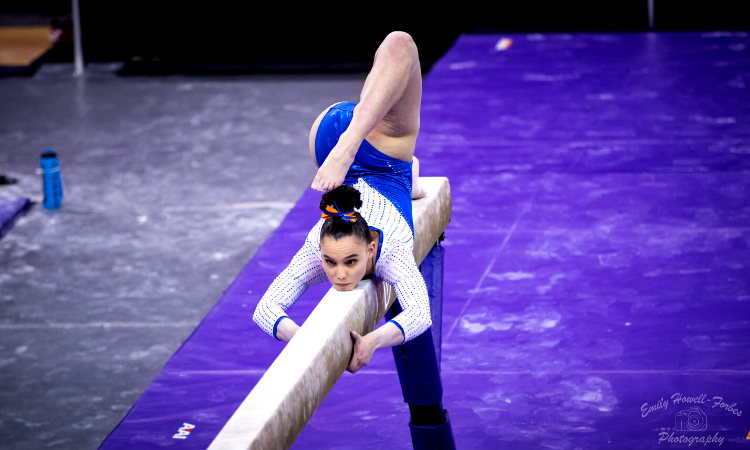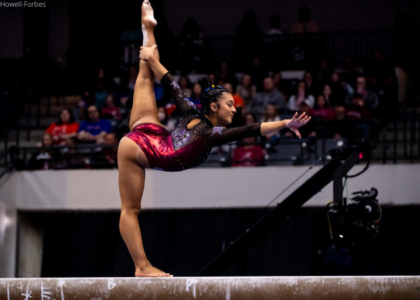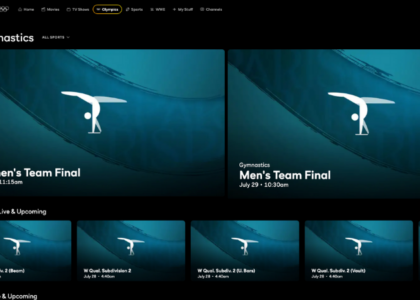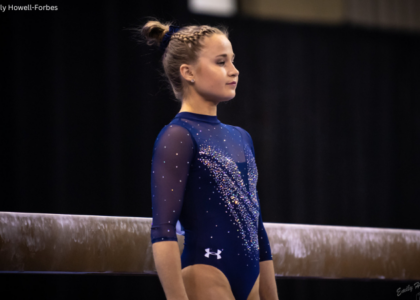After nearly two years, it’s almost time for NCAA gymnastics postseason again! We know where each of the top 36 teams in the country will travel to compete for a chance at advancing to nationals, and in the days leading up to the championships, we’ll preview and analyze each of the four regionals, discussing which teams have a chance of moving on each day and which individuals could qualify as well.
First up is the Salt Lake City regional. Thursday will feature No. 30 Temple and No. 34 Arizona in round one. Friday we jump into round two action with No. 6 Utah, No. 11 Arizona State, No. 17 Boise State, and No. 21 Southern Utah competing in the afternoon session and No. 3 LSU, No. 14 Kentucky, No. 22 Utah State, and the winner of round one in the evening session. Two teams from each of these Friday competitions will advance to round three on Saturday where the top two from that meet make it to nationals.
There’s also a handful of individuals that will compete on Friday in both of the round two meets. Simply put, the top all arounder and event specialists qualify to nationals. To determine those gymnasts, combine Friday’s individual event and all around results, wait until Saturday’s meet concludes, take out all the gymnasts from the two qualifying teams and take the top individual on each event and in the all around.
Easy enough, right?
For a more in-depth explanation, including how the tie-breaking procedure works (it’s complicated), how the whole format is structured and even how judges are selected, check out our NCAA postseason resource guide.
Finally, don’t forget to enter your postseason predictions in the 2021 bracket challenge! The deadline for submissions is Wednesday, March 31 at 7 p.m. ET. Once you enter, you can follow your progress here. Note that when you submit your picks, it will take up to a few hours to see your submission appear in the standings spreadsheet.
Round One
Date: Thursday, April 1 at 5:00 p.m. ET
How to Watch: ESPN3
Teams: No. 30 Temple and No. 34 Arizona
| Team | NQS | Average | High Score | Starting Event |
| No. 30 Temple | 195.963 | 194.748 | 196.500 | Vault |
| No. 34 Arizona | 195.781 | 195.128 | 196.075 | Bars |
Background
Temple was one of the biggest stories of the conference weekend, picking up the EAGL title in its first year in the conference and rocketing nine spots up the rankings with a monster program record. Temple’s three best scores of the season are its three most recent, and even better, all three were on the road. The Owls definitely have the benefit of momentum here. Arizona has comparable consistency but a substantially lower season high, as well as some unexplained absences from key contributors like Payton Bellows, Zaza Brovedani and Elena Deets intermittently throughout the season. The Wildcats haven’t put together their best lineups yet and obviously don’t have too many more chances to do so.
So You’re Saying There’s a Chance
If both teams perform at their best in Salt Lake City, Temple ought to win, albeit narrowly, despite the question mark of Arizona’s full depth remaining to be seen. But the pressure’s on early for the Owls: Temple bars is the only true weak event of this dual meet, coming in below 48.500 in five out of 12 meets this year. Arizona vault, which we’ll also see in the second rotation, is no cakewalk either, but it doesn’t have the same potential for outright collapse. Temple excels on floor with an NQS of 49.300, and it can likely close it out in the fourth rotation if the meet is close going in.
Routines You Shouldn’t Miss
Junior all arounder Ariana Castrence is a powerhouse for the Owls: In 2021 alone she’s recorded the three best all around scores in program history. You’ll also want to keep an eye out for Temple vault program record holder Julianna Roland, a transfer from Bridgeport who clinched the Owls’ qualification to regionals last weekend, veteran floor anchor Faith Leary and stylish freshmen Cyrena Whalen (UB) and Brooke Donabedian (BB, FX). Arizona is a young team: Freshmen Jessica Castles and Elena Deets are key late-lineup contributors on several events apiece. Sophomore Malia Hargrove is having a breakout season and produced great all around scores the last two weeks while Zaza Brovedani can be extraordinary on three events but has been in and out of lineups after an offseason concussion.
Round Two
Session One
Date: Friday, April 2 at 3 p.m. ET
How to Watch: ESPN3
Teams: No. 6 Utah, No. 11 Arizona State, No. 17 Boise State and No. 21 Southern Utah
| Team | NQS | Average | High Score | Starting Event |
| No. 6 Utah | 197.556 | 197.263 | 197.725 | Beam |
| No. 11 Arizona State | 197.088 | 196.423 | 197.450 | Bars |
| No. 17 Boise State | 196.788 | 196.168 | 196.900 | Floor |
| No. 21 Southern Utah | 196.675 | 196.048 | 197.275 | Vault |
Background
This is one of the round two sessions we’re most excited about. Arizona State likely doesn’t feel the same way. While the Sun Devils have had the best regular season of the Santos era, they’ve drawn not one but two of the country’s most dangerous unseeded teams and will have to be very careful not to let their postseason run end here. Utah on the other hand has been very consistent in 2021 and should feel fairly confident about its ability to cruise through Friday. We might see some more conservative lineup choices from the Utes so that they’re well rested and prepared to gun it on Saturday. Boise State has been quiet but excellent all year and can be relied upon to produce a solid total and cause trouble if Arizona State is anything less than excellent, while Southern Utah is a consummate wildcard (as always) with a massive peak score from February but challenges throughout March.
So You’re Saying There’s a Chance
Boise State is the big question mark. There’s a lot to like about the Broncos: Last week they outscored Arizona State by two and a half tenths. Keep in mind that while the Sun Devils were certainly lackluster at Pac-12s, they didn’t count a fall or even a sub-9.700 score. That means that they can go clean and still lose. Boise State also gets to finish the meet on its best event; the Broncos are ranked No. 12 on bars thanks in part to anchor Emily Muhlenhaupt. That’s not a great advantage over a solid Arizona State vault rotation, though.
For Southern Utah, it’s all about the lineups. Arguably the Thunderbirds’ four most important multi-event contributors—Karley McClain, Shylen Murakami, Hannah Nipp and Molly Jozwiakowski—have all missed weeks on some or all of their events in the month of March. This team is absolutely capable of hitting the gas at the perfect moment and pulling off an upset, and it’s certainly the most dangerous No. 4 seed in the country. But for that to happen, the best version of Southern Utah has to show up on the day.
Routines You Shouldn’t Miss
While Utah’s beam rotation has finally kicked into high gear, vault showed some cracks last weekend as one of the four 10.0 SV vaults fell and another was replaced by a full to avoid uncertainty in a pressure situation. While that was the right coaching choice for the moment and it delivered a championship title, watch that rotation closely, because generally speaking, a team doesn’t want to be entering postseason feeling like its anchor can’t be trusted to follow a fall. There are some great 10.0 vaults elsewhere in this session too, including Yurchenko one and a halves from Boise State’s Courtney Blackson and Arizona State’s Anaya Smith, as well as a Tsuk tuck one and a half from Southern Utah’s Molly Jozwiakowski (if she competes…).
It’s also a massive bars session, including top-50 competitors Cairo Leonard-Baker and Sarah Clark from Arizona State, national No. 4 Muhlenhaupt and newcomer Courtney Blackson, who does an astoundingly clean Markelov. For Southern Utah, besides the four big names already mentioned, keep an eye out for Morgan Alfaro’s Yurchenko full. She’s ultra-consistent and tied in the national rankings with familiar names like Mya Hooten and Ellie Lazzari.
| All Around | Vault | Bars | Beam | Floor |
| Tara Kofmehl, Northern Illinois (with Southern Utah) | Deja Chambliss, George Washington (with Arizona State) | Natalie Hamp, Northern Illinois (with Southern Utah) | Zoie Schroeder, Northern Illinois (with Southern Utah) | Anna Kaziska, SEMO (with Boise State) |
| Anna Kaziska, SEMO (with Boise State) | ||||
Individuals to Keep an Eye on
Of the athletes who qualified to regionals as individuals, Natalie Hamp’s bar routine is arguably the biggest deal in this session. She’s ranked in the top 50 and has topped out at 9.925. Anna Kaziska also has a peak score of 9.925, though in this field, even that is unlikely to threaten for nationals. From the qualified teams, Muhlenhaupt is the highest-ranked bars gymnast in Salt Lake City and thus the favorite to qualify to nationals, assuming Boise State doesn’t make the cut as a team. Sun Devil Hannah Scharf is the highest-ranked all arounder and floor competitor outside of Utah, and Anaya Smith leads the way on vault. No non-Utah beamers from this semifinal rank in the top 50, so that qualification spot will be anyone’s for the taking.
Session Two
Date: Friday, April 2 at 8 p.m. ET
How to Watch: ESPN3
Teams: No. 3 LSU, No. 14 Kentucky, No. 22 Utah State and No. 30 Temple or No. 34 Arizona
| Team | NQS | Average | High Score | Starting Event |
| No. 3 LSU | 197.813 | 197.378 | 198.050 | Beam |
| No. 14 Kentucky | 196.969 | 196.547 | 197.100 | Bars |
| No. 22 Utah State | 196.531 | 195.943 | 196.775 | Floor |
| No. 30 Temple OR No. 34 Arizona | — | — | — | Vault |
Background
LSU has more or less cruised through the season and should more or less cruise through this regional semifinal too. There are reasons to doubt LSU as a final four team, but a bad day for the Tigers is still substantially better than a good day for Utah State, so there’s not much that can go wrong. Kentucky on the other hand hasn’t looked like a shoo-in. The Wildcats sharpened up after a mediocre January and now have a healthy set of scores bunched together around the 197 mark (peep that very small high score/NQS differential), but it doesn’t take more than a few iffy handstands to drop them into Utah State’s shooting range. The Aggies have three scores of 196.500-plus but substantial variance throughout the season.
So You’re Saying There’s a Chance
There’s a chance that Temple could stroll through this with a season high or something close. It’s a very edge scenario, but something in that 196.500 universe could do the job if things get weird for the other two teams. The Wildcats have four scores (out of nine) under Utah State’s NQS. On the other hand, those four scores are all from January and everything since has been above the Aggies’ season high. It would take an aberration to drop Kentucky into the danger zone—but not a major one. It’s also worth noting that while both of Kentucky’s 197-plus scores were at home, all four of Utah State’s NQS-counting scores were on the road. Utah State will be much more comfortable at a neutral site. An upset here isn’t a likelihood—the four-tenth NQS gap is still substantial—but there are definitely ways to talk yourself into believing it.
Routines You Shouldn’t Miss
For LSU we’ll be watching lineups closely—specifically, how many of them Kiya Johnson is healthy enough to be in. The sophomore has put up great all around numbers for the last two weeks and we has to assume that her weeks off from floor were specifically intended to preserve her for postseason. But it’s unlikely we’ve heard the end of her Achilles drama. In something of a return to form for the Wildcats (think of the golden days of the class of 2019 plus Mollie Korth), Kentucky is all about its three all arounders. Junior Josie Angeny has relished in taking advantage of the power vacuum in Lexington while sophomore Raena Worley became the superstar her level 10 scores told us she should be. Ultra-consistent freshman Bailey Bunn became an immediate fan favorite as well. New Zealand’s finest, Maia Fishwick, has topped out at 9.950 this year on bars for Utah State while senior Autumn DeHarde is one of the country’s best beam gymnasts and can put up a big number on floor too.
| All Around | Vault | Bars | Beam | Floor |
| Ariana Castrence, Temple (with Arizona) | Julianna Roland, Temple (with Arizona) | Alexandra Fochler, Bowling Green (with Kentucky) | Jessica Castles, Arizona (with Temple) | Julianna Roland, Temple (with Arizona) |
| Skylar Killough-Wilhelm, Washington (with Utah State) | Malia Hargrove, Arizona (with Temple) | Geneva Thompson, Washington (with Utah State) | Sirena Linton, Arizona (with Temple) | Faith Leary, Temple (with Arizona) |
| Geneva Thompson, Washington (with Utah State) | Amara Cunningham, Washington (with Utah State) | |||
| Allie Smith, Washington (with Utah State) | Malia Hargrove, Arizona (with Temple) | |||
| Amara Cunningham, Washington (with Utah State) | ||||
*Note: Individuals from both round one teams are included in the individual draw to account for one team being eliminated after Thursday’s competition. The spots from the individuals on the advancing team will not be filled.
Individuals to Keep an Eye on
This is an interesting set of specialists, with the best of two very talented play-in teams joining the remains of Washington’s postseason qualifiers. It’s a particularly strong vault group, with Roland and Geneva Thompson’s stickable Yurchenko fulls (remember that Roland is a program record holder for Temple on this event and Thompson has received a perfect 9.950 for hers), joining Allie Smith’s tucked one and a half and Malia Hargrove’s laid out one. Hargrove sometimes downgrades to the full, but expect her to go all out on Friday with nothing to lose. Amara Cunningham usually also competes a great full, but she’s been training her old one and a half this week.
Cunningham is also a major contender on floor, where she boasts a season high of 9.950 and is No. 21 in the country. In terms of individuals from qualified teams who could threaten for nationals, keep an eye on Worley who is tied with Cunningham at No. 21 on floor. That’s only if Worley doesn’t advance as an all arounder, though, and as the highest-ranked all around gymnast outside of LSU and Utah, she’s the favorite to do so.
Round Three
Date: Saturday, April 3 at 8 p.m. ET
How to Watch: ESPN3
Teams: top two teams from each Friday session
| Starting Event | Team |
| Vault | Session 2, Team 1 |
| Bars | Session 1, Team 1 |
| Beam | Session 1, Team 2 |
| Floor | Session 2, Team 2 |
The Bottom Line
LSU and Utah should ultimately feel pretty good about their chances here, no matter who joins them in the final. This is a regional with a fascinating Friday but a substantially less interesting Saturday—that’s just how things turn out sometimes. A hot Arizona State is the only real threat if neither of the two favorites count falls, and recall that Arizona State’s road season high is just 197.050. Both LSU and Utah can have some substantial drama and still come out above that number. For Utah, the nightmare scenario is probably a bland bar rotation to start and then a counted fall on vault at the last minute—basically the alternate universe version of its meet at Pac-12s, with no red-hot beam and floor in the middle to bail out the other two events. For LSU, the bubble has already burst on very high bars scores, and that’s unlikely to change from here on out. Counting a beam fall is also a real threat for the Tigers, and in both meets where that happened this year, LSU came out below 197.000. Ultimately, though, that scenario just isn’t likely to happen on the same day as a perfect Arizona State meet. There are worlds where someone besides Utah and LSU moves on to nationals from this regional, but there aren’t many of them.
READ THIS NEXT: The NCAA Postseason Format, Explained
Article by Rebecca Scally and Katherine Weaver
Like what you see? Consider donating to support our efforts throughout the year! [wpedon id=”13158″]




